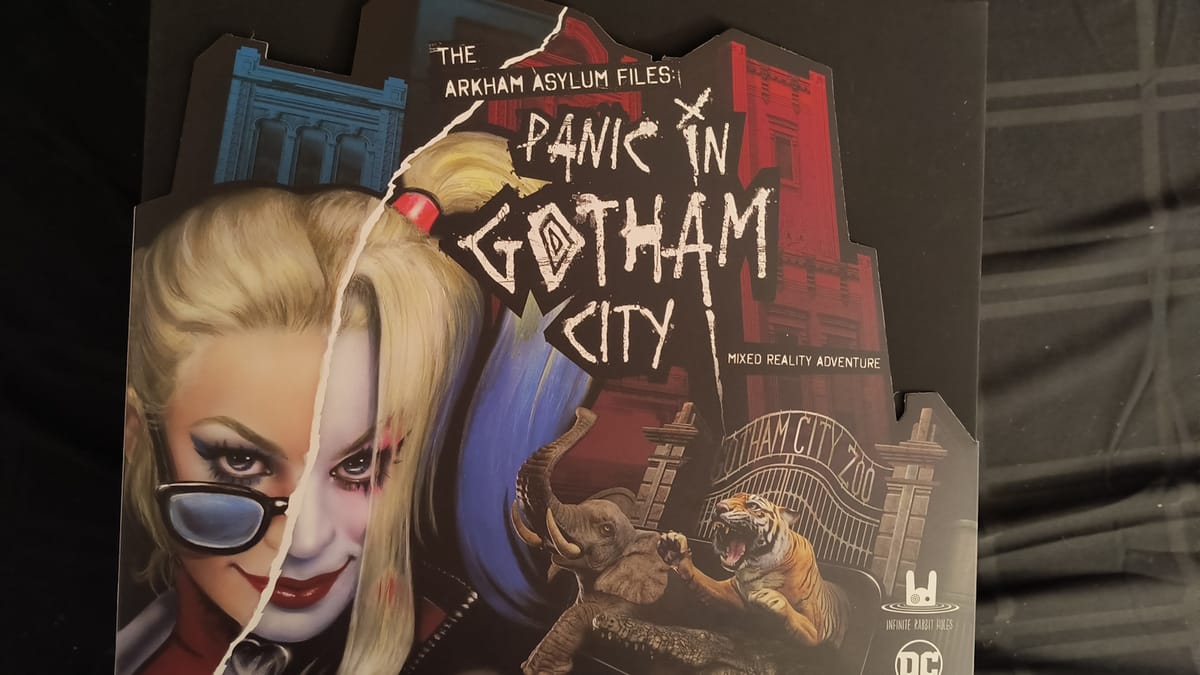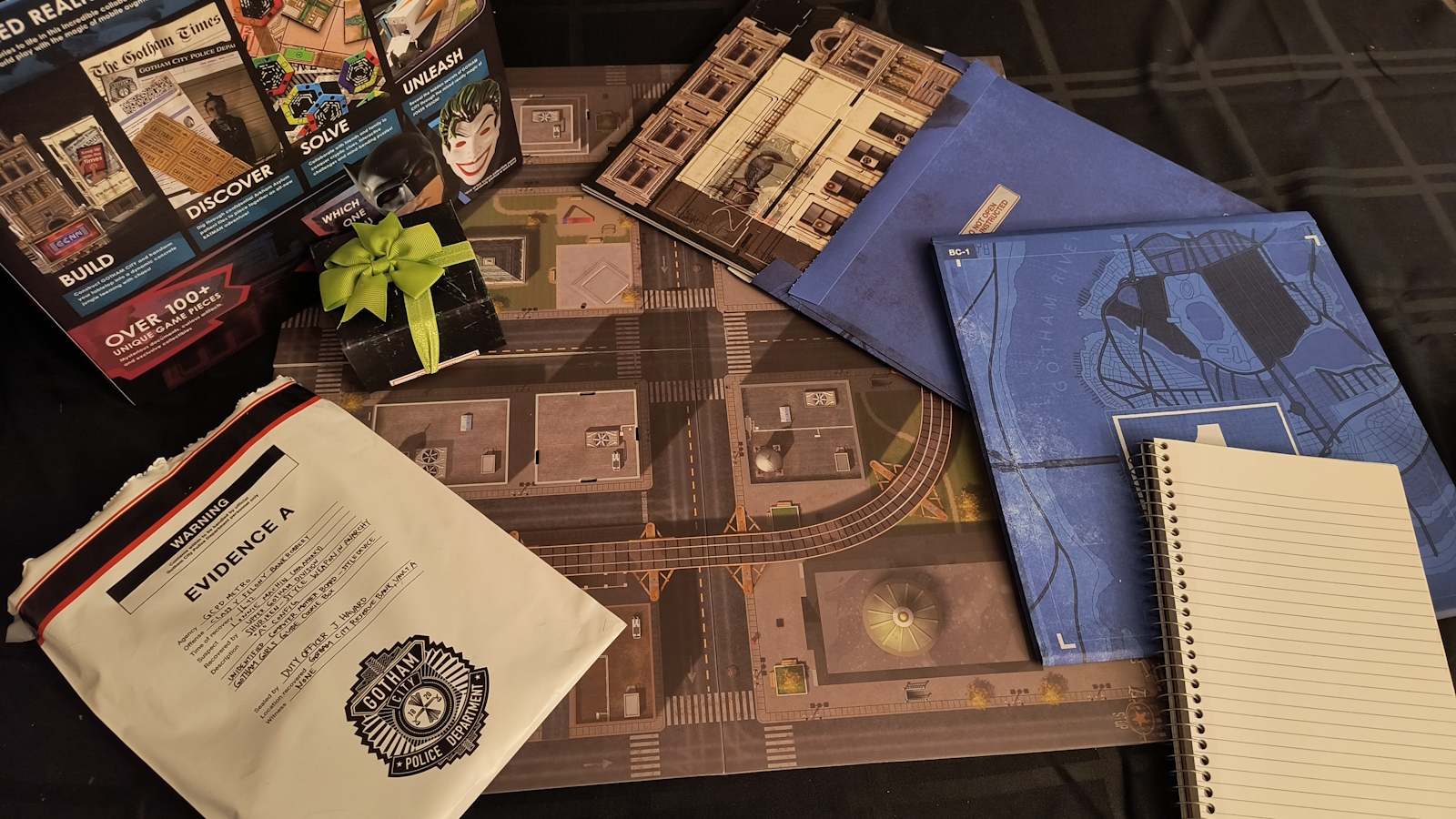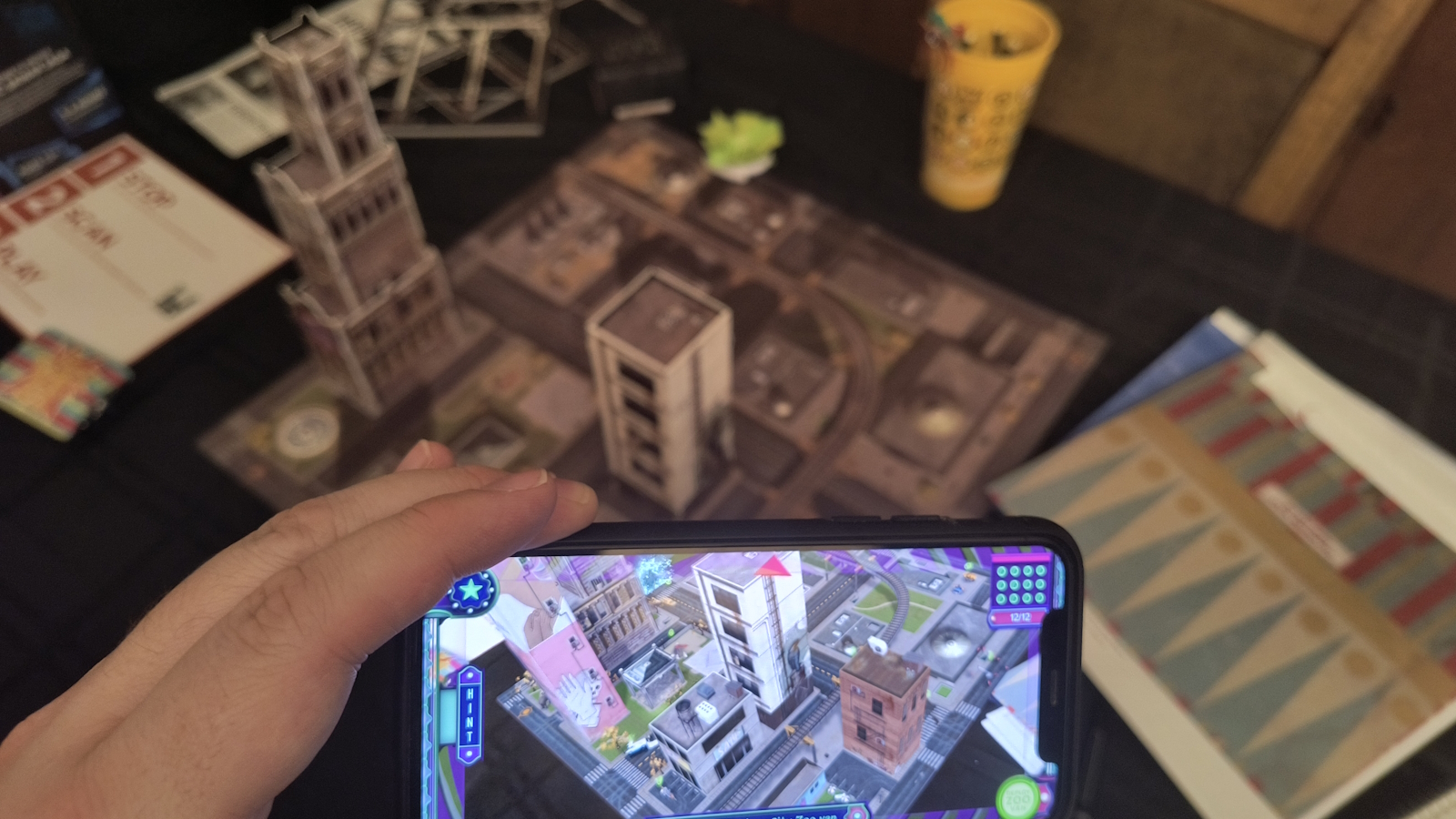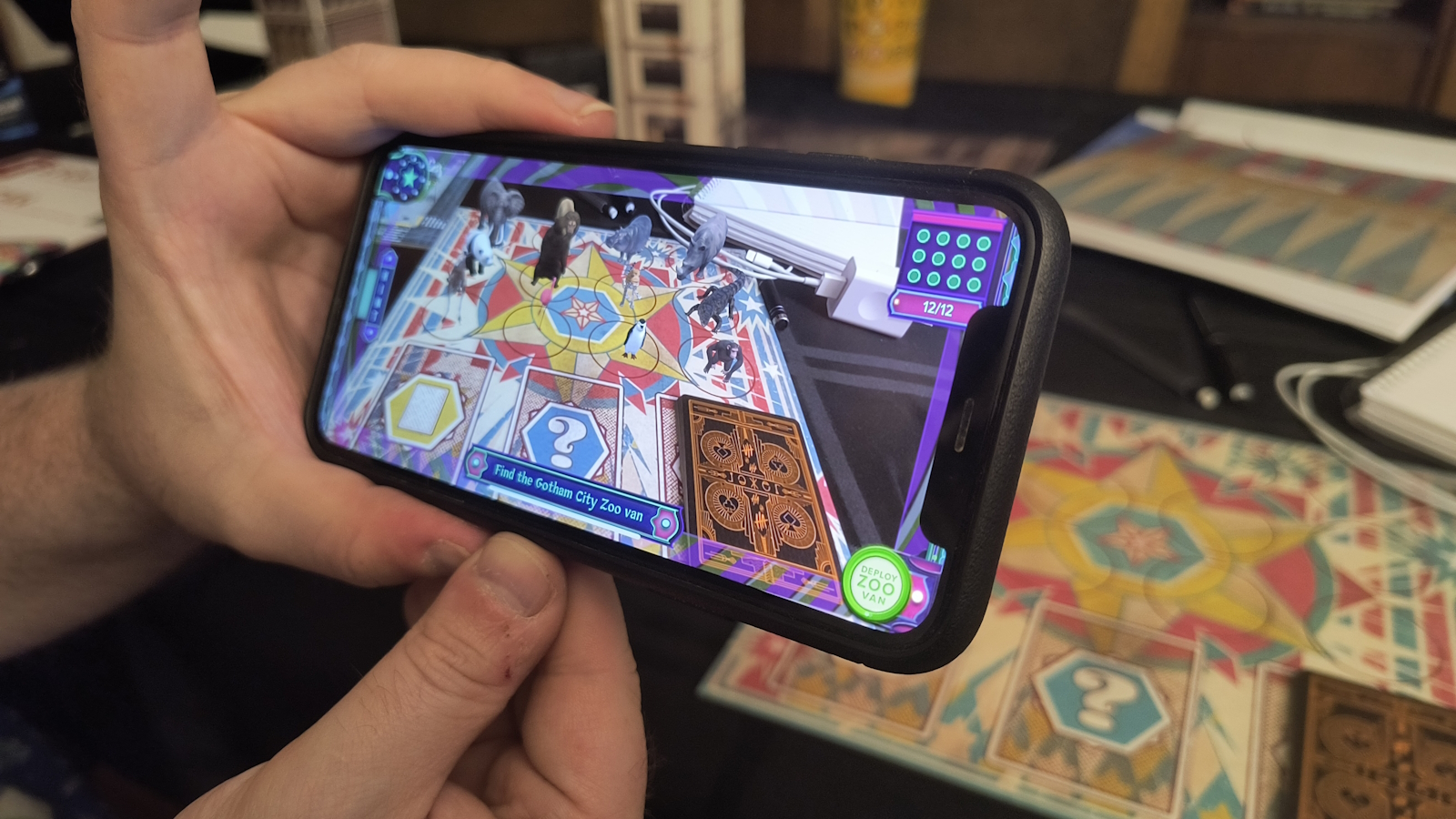
Someone got her medical license back, and she’s ready to get back to working at Arkham Asylum. That’s right, Harlene Quinzel, AKA Harley Quinn, AKA Joker’s right hand clown before the divorce, has turned over a new leaf and is back working at Arkham Asylum. Between your group (some amateur sleuthing citizens of Gotham) and her, you’ll solve a bunch of puzzles to follow a story of crime and punishment in DC’s moody city.
Panic in Gotham City is a group mixed reality game created by Infinite Rabbit Holes. It uses an app to guide the progress, but also uses your smart phone’s AR capability to make a bunch of cool things happen, almost like magic. I don’t want to spoil anything here, but there’s a few things I’m going to vaguely talk about to better give folks an idea of what you’ll get in the box.
First things first, when you open the box, it tells you to go ahead and download the app. This is where I ran into my first stumbling block in this review. At the time of writing this, there is still no Android app to play this game. I wound up having to borrow an iPhone from someone to even review the game. The iPhone also has to be new enough to have AR capability. To be safe, check to see if you can download the Panic in Gotham app in the App Store before you get this. When they do finally get an Android version out, I suspect that there will be similar limitations, as not all Android phones have the sensors to do AR.
So, iPhone in hand, I got the app, and from here the game asks you to open an envelope in the box, perform some mixed reality activities using the components within, and then move onto the next envelope. Rinse and repeat for 8 chapters, and by the end, you’ll have experienced a story centering on a handful of Batman’s lesser known rogues. The story itself is pretty darn good for a licensed product. Between top-notch voice acting, and a deep exploration of a very undersold villain, you experience and solve a wild heist.
The activities are definitely the best part of the experience, using photos, a whole newspaper, and cardboard components to solve puzzles. None of the puzzles are overly difficult, and only two got my group stuck for any amount of time. However, these stumpers both had some hiccups in design and implementation, not difficulty. These were definitely the lows of the game, but very few and far between.
When these puzzles are at their best though, they feel amazing. You can scan the various physical pieces, and the app snaps onto them, bringing them into an enhanced AR version of the world. Manipulating the pieces in the AR world is, unfortunately, not something that’s effectively designed (with a few memorable exceptions). Basically, for the most part, if you move something, you have to wait for the app to re-scan it before it appears again. Some of the puzzles REALLY feel like they were supposed to let you manipulate the AR components in real time, but I guess the technology just isn’t there quite yet.
Yet when these puzzles are at their worst, you wonder why the AR is required at all. AR will reveal stuff that’s not on the base components, but I can’t help but wonder why they weren’t printed there to begin with. This is doubly so when you find a blacklight early on, which is used once at the beginning and then completely forgotten for almost the entire rest of the game. The game also uses solutions that are sometimes easy to guess based on the first few decoded letters and some context. In the less exciting puzzles this comes as a blessing, but in others you basically finish the puzzle after only a tiny bit of work, leaving the puzzle itself half-solved. The designers seemed to recognize this, because in the highest quality set-pieces, the solutions are not something you could possibly guess, instead using codes or combinations.
In addition to solving puzzles, you’ll slowly build a few model buildings for your miniature Gotham City. The buildings you construct are not exactly what I’d call landmarks of the series, more like props the AR program uses to do some of its magic. For example, instead of building Ace Chemicals, you assemble a building next to it, which brings Ace Chemicals into the AR version of the city. I feel like it’s a missed opportunity that we’re not erecting the Way ne Enterprises building, or Arkham Asylum, or the Iceberg Lounge. Still, putting together the buildings like a 3d puzzle is a fun activity, even if it’s not exactly mentally stimulating.
ne Enterprises building, or Arkham Asylum, or the Iceberg Lounge. Still, putting together the buildings like a 3d puzzle is a fun activity, even if it’s not exactly mentally stimulating.
The app has other functions, like many story sequences, both comic book style, and live action news broadcasts, that help tell the story. It’s a bit odd that it uses both styles, but works well enough. The app also plays music during puzzle sequences, much of which is very high quality stuff. There were a few times I paused in puzzling to jam out for 30 seconds while a particularly good song played. None of the music sticks around for long before it brings back the sounds of the city-scape. It’s more to break up the monotony if you’re stuck on a puzzle than to underscore every moment of the game.
The puzzle difficulty is my other major qualm with this game. I don’t consider myself an incredible riddle solver, but to me these puzzles were more effort and activity than conundrum. My guess is that they didn’t want to stump kids playing this on their own. I didn’t have kids to test this on myself, but I imagine that these would feel like real revelations for the teen bracket the game markets itself towards.
The components and app are very high quality. On the iPhone I used, I ran into a few glitches with the AR tracking, but nothing too jarring. The city diorama is a wonderful centerpiece to the whole production, while the bits and bobs, even if only used once through the story, still feel high quality. It earns its hefty price tag, for sure.
My biggest gripe is how annoying it is to put it back in its box. In fact, I would say it’s pretty much impossible to pack up between chapters, as rebuilding the buildings would be too much effort between chapters, and they seem required for the AR cityscape to function. This will probably sit on a table for however long it takes you to play through it before you pack it up and put it back in its box. All of the components do fit nicely back in the box, even the punched out bits, but the envelopes and seals all remain open, meaning there is no way to go back to a truly “like new” state. There are also some plastic components that will never go back to how you got them out in the first place, but that’s the only exception. If you put everything back in properly, which the app will helpfully load up a very well designed website to help you out with, then you can pull the game out and play it again later with a new group. Since the puzzle solutions don’t appear to change, it’s probably best to act as a guide or facilitator if you play it a second time. Overall, it takes about an hour to put everything back where it came from, assuming you want it to be prepared for another playthrough.
My last criticism is that this missed a few opportunities in my mind. For one, the game only calls back to previous envelopes two times (outside of the main city diorama). Both of those callbacks are just to play a video through AR, which really could have just played on the phone without the AR component. The game also pulls a fast one with a certain character, who is well advertised and shows up on the box, but doesn’t really feature in the story of this game. It just feels a bit dishonest, and more of a marketing choice than one made by the developers.
Overall, Panic in Gotham City is a good, 8-ish hour adventure. It’s part escape room, part puzzle game, and an utterly unique experience. I think the developers leaned into the AR side of things a bit too hard for my own liking, but as a showcase of the technology in action, it is quite impressive. I look forward to seeing more from Infinite Rabbit Holes, as the AR puzzle room idea has a lot of potential. However, the $149 price tag does make it hard to recommend to any but the most die-hard of Batman fans.
The Arkham Asylum Files: Panic in Gotham City
Great
An augmented reality puzzle solving game with great quality. None of the puzzles are going to be too hard for most people, but are fun and diverse enough for everyone to have a good time regardless.
Pros
- Interesting and diverse range of puzzles.
- Deep dive into a fascinating and underdeveloped villain in Batman canon.
- Amazing audio, visual, and writing quality throughout.
Cons
- Many of the puzzles rely on the AR mechanic to their detriment
- Cannot be reverted to a true "Like new" state
- No support for many smart phones
- Very high price for an 8 hour experience.
